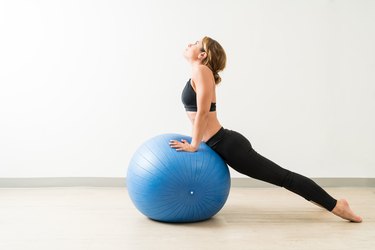
Exercise balls — also known as stability balls, balance balls and Swiss balls — are fantastic tools for general strength training and working your core. Instead of worrying about your exercise ball inflation pressure, focus on its size: Each ball is meant to be inflated to a certain diameter.
Tip
You can also use an exercise ball as a substitute for a desk chair.
Video of the Day
Exercise Ball Inflation Size
Many exercise balls are labeled with their intended inflation diameter in centimeters; if that information isn't on the ball itself, it'll be on the packaging that came with the ball. In general, you choose the ball size according to your height. Here are a few common exercise ball diameters, and the height range they correspond with, as recommended by the American Council on Exercise (ACE):
Video of the Day
- 45 centimeter: under 5 feet
- 55 centimeters: 5 feet to 5 feet, 7 inches
- 65 centimeters: 5 feet, 8 inches to 6 feet, 3 inches
- 75 centimeters: over 6 feet, 3 inches
The recommendations for exercise ball inflation size do vary somewhat between expert organizations. For example, the American College of Sports Medicine recommends exercise balls that are 45 centimeters in diameter for those who are between 4 feet, 8 inches and 5 feet, 5 inches tall.
When in doubt, follow this excellent advice from the Mayo Clinic: For most exercises, especially ones for working your core, they say, you'll want a ball that positions you with your knees at a right angle when you sit on it. They also note that if you deflate the ball a bit, it'll make most exercises a little easier. So although you should never inflate an exercise ball beyond its intended diameter, you can safely let a bit of air out and use the ball at a slightly smaller diameter.
Inflating Your Exercise Ball
Most exercise balls come with a small hand pump in the package. While this does work to inflate the ball, it's perfectly fine to use an air compressor for an exercise ball — as long as the exercise ball manufacturer doesn't prohibit it (check the instructions) and as long as you don't accidentally over-inflate the ball.
You can also use a bicycle pump, as long as you have the right adapter to use with the exercise ball — usually the adapter is shaped like a narrow, tapered cone.
Most people aren't equipped to eyeball the diameter of an exercise ball, but the manufacturers have accounted for that. Exercise balls are often packed with a thin plastic strip that wraps around your exercise ball as a way of checking its diameter. These strips usually have a hole in each end. Here's how to use them:
Place the nozzle of the air pump through both of the holes, so the strip forms a loop hanging off the air nozzle.
Make sure the strip isn't twisted; it needs to lay flush against the surface of your exercise ball.
Insert the air nozzle into the hole on the exercise ball and begin inflating the ball. As the ball gets larger, you might need to maneuver the strip a bit. It should sit around the inflated ball like a belt —
or like the equator sits around a globe.
Once the slack is out of the strip, your ball has reached the intended diameter. Locate the air plug for the exercise ball, remove the air nozzle and measuring strip, and quickly insert the plug.
As noted by ACE, exercise balls naturally shrink a bit over time as air escapes — but you can always add more air. You can check the ball's diameter with the measuring strip, or by placing a pair of chairs as far apart as the ball's intended diameter. If the ball passes through the chairs without touching them, it's lost some air. You'll also notice the exercise ball gradually getting softer as air escapes.
Read more: How to Remove an Exercise Ball Plug
Tip
Always read the instructions for your exercise ball; some manufacturers may recommend letting the ball sit for a few hours after inflation before you start using it. This gives the plastic time to stretch.